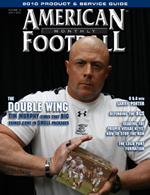Article CategoriesAFM Magazine
|
Strength Report: (Don’t) Assume The Athletic Positionby: Joe Kenn MA, CSCS, SCCCDirector of Athlete Development – Football, University of Louisville © More from this issue In all sports, the rudimentary beginnings of movement start with a specific stance or posture. Whether it is a defensive stance on the basketball court, a three-point stance for an offensive lineman, a batter preparing to hit a baseball or a weightlifter preparing for his final clean and jerk, there is a proper starting position. All of these athletes must be taught the fundamentals of a proper stance to place them in a position to be successful. Everything successful in sports starts with a proper starting position. The simple foundation of all sports, the stance, is often times overlooked because of the ever increasing natural athleticism of athletes of this era.
|
|
|||||||
| HOME |
MAGAZINE |
SUBSCRIBE | ONLINE COLUMNISTS | COACHING VIDEOS |
Copyright 2025, AmericanFootballMonthly.com
All Rights Reserved





